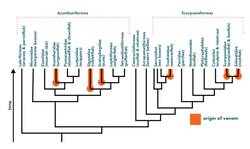
Back Filogenie Afrikaans Filochenia AN علم الوراثة العرقي Arabic Filoxenia AST Filogenetika Azerbaijani Філагенетыка Byelorussian Филогения Bulgarian Filogenetika BS Filogènia Catalan Fylogenetika Czech
This article needs additional citations for verification. (February 2024) |
| Part of a series on |
| Evolutionary biology |
|---|
 |
In biology, phylogenetics (/ˌfaɪloʊdʒəˈnɛtɪks, -lə-/)[1][2][3] is the study of the evolutionary history of life using observable characteristics of organisms (or genes), which is known as phylogenetic inference. It infers the relationship among organisms based on empirical data and observed heritable traits of DNA sequences, protein amino acid sequences, and morphology. The results are a phylogenetic tree—a diagram depicting the hypothetical relationships among the organisms, reflecting their inferred evolutionary history.[4]
The tips of a phylogenetic tree represent the observed entities, which can be living taxa or fossils. A phylogenetic diagram can be rooted or unrooted. A rooted tree diagram indicates the hypothetical common ancestor of the taxa represented on the tree. An unrooted tree diagram (a network) makes no assumption about directionality of character state transformation, and does not show the origin or "root" of the taxa in question.[5]
In addition to their use for inferring phylogenetic patterns among taxa, phylogenetic analyses are often employed to represent relationships among genes or individual organisms. Such uses have become central to understanding biodiversity, evolution, ecology, and genomes.
Phylogenetics is a component of systematics that uses similarities and differences of the characteristics of species to interpret their evolutionary relationships and origins. [6]
In the field of cancer research, phylogenetics can be used to study the clonal evolution of tumors and molecular chronology, predicting and showing how cell populations vary throughout the progression of the disease and during treatment, using whole genome sequencing techniques.[7] Because cancer cells reproduce mitotically, the evolutionary processes behind cancer progression are quite different from those in sexually-reproducing species. These differences manifest in several areas: the types of aberrations that occur, the rates of mutation, the high heterogeneity (variability) of tumor cell subclones, and the absence of genetic recombination.[8][9]
Phylogenetics can also aid in drug design and discovery. Phylogenetics allows scientists to organize species and can show which species are likely to have inherited particular traits that are medically useful, such as producing biologically active compounds - those that have effects on the human body. For example, in drug discovery, venom-producing animals are particularly useful. Venoms from these animals produce several important drugs, e.g., ACE inhibitors and Prialt (Ziconotide). To find new venoms, scientists turn to phylogenetics to screen for closely related species that may have the same useful traits.

The phylogenetic tree shows venomous species of fish, and related fish they may also contain the trait. Using this approach, biologists are able to identify the fish, snake and lizard species that may be venomous. [10]
In forensic science, phylogenetic tools are useful to assess DNA evidence for court cases. Phylogenetic analysis has been used in criminal trials to exonerate or hold individuals.
HIV forensics uses phylogenetic analysis to track the differences in HIV genes and determine the relatedness of two samples. HIV forensics have limitations, i.e., it cannot be the sole proof of transmission between individuals, and phylogenetic analysis which shows transmission relatedness does not indicate direction of transmission.[11]
- ^ "phylogenetic". Dictionary.com Unabridged (Online). n.d.
- ^ "phylogenetic". Merriam-Webster.com Dictionary. Merriam-Webster.
- ^ from Greek φυλή/φῦλον [phylé/phylon] "tribe, clan, race", and γενετικός [genetikós] "origin, source, birth" Liddell, Henry George; Scott, Robert; Jones, Henry Stuart (1968). A Greek-English lexicon (9 ed.). Oxford: Clarendon Press. p. 1961.
- ^ "phylogeny". Biology online. Retrieved 15 February 2013.
- ^ Itzik, Peer (1 January 2001). "Phylogenetic Trees". www.cs.tau.ac.il.
- ^ Harris, Katherine (23 June 2019). Taxonomy & Phylogeny. Biology LibreTexts. Retrieved 19 April 2023.
- ^ Herberts, Cameron; Annala, Matti; Sipola, Joonatan; Ng, Sarah W. S.; Chen, Xinyi E.; Nurminen, Anssi; Korhonen, Olga V.; Munzur, Aslı D.; Beja, Kevin; Schönlau, Elena; Bernales, Cecily Q.; Ritch, Elie; Bacon, Jack V. W.; Lack, Nathan A.; Nykter, Matti (August 2022). "Deep whole-genome ctDNA chronology of treatment-resistant prostate cancer". Nature. 608 (7921): 199–208. Bibcode:2022Natur.608..199H. doi:10.1038/s41586-022-04975-9. ISSN 1476-4687. PMID 35859180. S2CID 250730778.
- ^ Schwartz, Russell; Schäffer, Alejandro A. (April 2017). "The evolution of tumour phylogenetics: principles and practice". Nature Reviews Genetics. 18 (4): 213–229. doi:10.1038/nrg.2016.170. ISSN 1471-0056. PMC 5886015. PMID 28190876.
- ^ Ní Leathlobhair, Máire; Lenski, Richard E. (2022). "Population genetics of clonally transmissible cancers". Nature Ecology & Evolution. 6 (8): 1077–1089. Bibcode:2022NatEE...6.1077N. doi:10.1038/s41559-022-01790-3. ISSN 2397-334X. PMID 35879542.
- ^ a b "Drug discovery - Understanding Evolution". 7 July 2021. Retrieved 23 April 2023.
- ^ Bernard, EJ; Azad, Y; Vandamme, AM; Weait, M; Geretti, AM (2007). "HIV forensics: pitfalls and acceptable standards in the use of phylogenetic analysis as evidence in criminal investigations of HIV transmission". HIV Medicine. 8 (6): 382–387. doi:10.1111/j.1468-1293.2007.00486.x. ISSN 1464-2662. PMID 17661846. S2CID 38883310.
© MMXXIII Rich X Search. We shall prevail. All rights reserved. Rich X Search